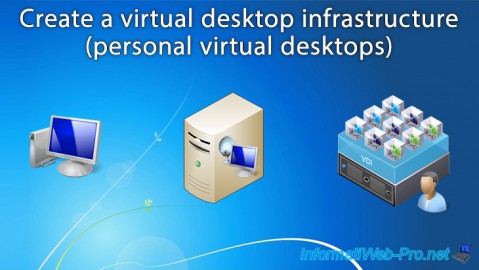Create a virtual desktop infrastructure (pooled virtual desktops) on Windows Server 2012 / 2012 R2 - RDS - VDI
- Windows Server
- 27 December 2019 at 12:53 UTC
-

- 4/6
7. Virtual destkop test
7.1. User side
To test our virtual desktop pool, we will create a new user.

Then, on a client computer (linked to the Active Directory), go to the web interface of your RDS server and log in with a user of the Active Directory.

Click on the displayed virtual desktop.
In our case : Win 8 Enterprise.

If you want to manage the device redirection options, click "View details".

Choose the options you want, and then click Connect.

As you can see, the user can easily see that this is a virtual machine and not a session on a physical server.

Once the virtual desktop is started (if it isn't already the case), a session will be automatically opened on it with the identifiers previously used.

As expected, you arrive on the Windows 8 home screen.

As you can see in the bottom right, it's Windows 8 Enterprise.

In the device manager, you will find the Microsoft RemoteFX Graphics Device - WDDM (if RemoteFX is enabled in the template used for your virtual desktops).

7.2. Server side
On your Hyper-V server, you will see that a virtual machine (virtual desktop) has restarted earlier than the others.
This is because virtual desktops are restored when the user logs off.

On your RDS server, you can see which users are currently using your virtual desktops.
In our case : we see that our user "INFORMATIWEB\InformatiUser" is currently using our "Win8-vm-1" virtual desktop.

Log off in the virtual desktop from the client computer.

Now, virtual desktops are available again for other users.
It's therefore important to explain to your users that they must log off when they no longer use their virtual desktop (and not just close the Windows Remote Desktop window).

7.3. User limit reached
As previously explained, each virtual desktop can be used by only 1 user.
By creating 2 virtual desktops, you allow up to 2 users to use this virtual desktop.

If all virtual desktops are already assigned to other users, the next user will receive a "There are no available computers in the pool. Try connecting again, or contact your network administrator." error.

8. Virtual desktop collection properties
To access the properties of your virtual desktop collection, go to your RDS server, choose your collection, and then click Tasks in the "Properties" section.

In the properties, you will find :
- the name of the collection : the one displayed on the users side
- the ID of the collection
- the description (optional)
- if this collection of virtual desktops is displayed in web access
- the collection's type
- the number of virtual desktops available in this collection

In the "Virtual Desktops" section, you will find :
- information about the Active Directory domain and the organizational unit in which they are stored
- the location (on the hard disk) where the virtual desktops are stored
- the location of the template used to create these virtual desktops
- the format used to generate virtual desktops

In the "User Groups" section, you will be able to manage which user groups are allowed to connect to this virtual desktop collection.

In the Client section, you can enable or disable redirection of user devices, printers, and restrict the redirection of monitors.

Finally, you will be able to manage the user profile disks :
- where these must be stored
- what should or should not be stored in user profile disks



No comment